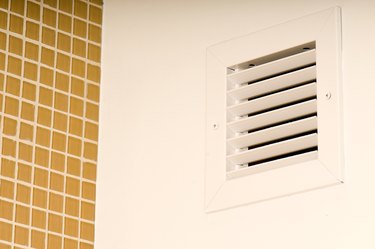
A house's heating, ventilation and air-conditioning (HVAC) system uses return air vents to facilitate air flow to and from the system's air ducts. Most rooms in the house that have an HVAC vent also should have a return vent, with the exception of the bathroom and kitchen.
Purpose
Video of the Day
Return vents increase the cooling and heating efficiency of the HVAC system. Without return vents in place, the HVAC system only pushes hot or cold air into a house's individual rooms, while air that has not been heated or cooled has nowhere to go unless a door or window is open, which lets outside air into the house. A return vent pulls air out of its room, making the effort to push heated or cooled air into the room an easier effort for the HVAC system. In addition, return vents supply more air for the HVAC system to heat or cool.
Video of the Day
Every Room vs. Some Rooms
Because return vents help increase the HVAC system's efficiency, installing a return vent in each room provides is more beneficial than installing return vents in only a few rooms. If the return vents can be closed, you may close the return vents in rooms that are warm or cool enough, helping draw more of the heated or cooled air into the house's other rooms.
Bathroom
Even though having a return vent installed in every room increases the HVAC system's efficiency, installing a return vent in a bathroom can lead to problems. The primary problem is that a bathroom's air may be humid after anyone takes a shower or bath, which is why a bathroom's ceiling should have an exhaust fan to remove the humid air. A bathroom return vent would draw the humid air, introducing humidity to the HVAC system, which leads to damage and decreased HVAC efficiency. In addition, unpleasant odors in the bathroom could be drawn into the HVAC system and distributed throughout the house.
Kitchen
Installing a return vent in a kitchen is also a bad idea because a kitchen also may contain some odors you would not want spread to other rooms. Depending on the location of a kitchen's return air vent, it may draw humid air from a boiling pot on the stove, a dishwasher exhausting its hot and humid air or steaming hot water sitting in the sink. Also, cooking may produce small amounts of smoke, which can be drawn into the HVAC system by a kitchen return vent and possibly set off smoke detectors in other parts of the house.